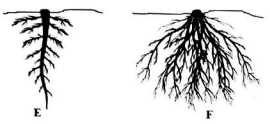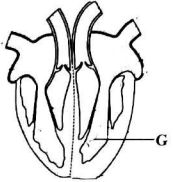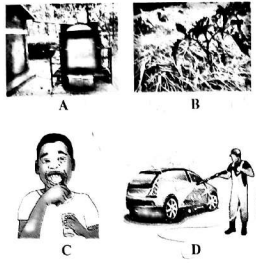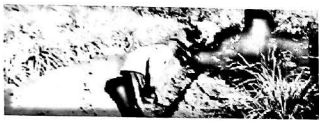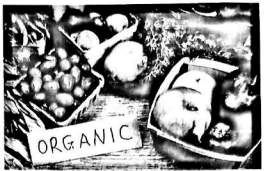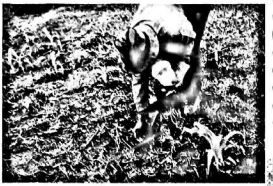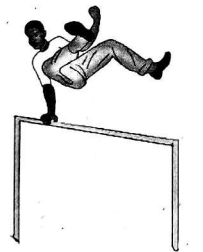- During a lesson, Grade 6 learners discussed functions of different parts of a plant. Which part of a plant is responsible for making plant food?
- Root.
- Stem
- Fruit.
- Leaf.
- The following diagrams were drawn by learners to represent two types of root systems E and F.
Which one of the following pairs of plants is matched to its correct root system.
E F
A. Maize Sugarcane
B. Beans Maize
C. Sisal Beans
D. Sugarcane Sisal - During a class activity, learners recorded the following observations about a group of invertebrates:
- three body parts;
- three pairs of legs;
- have wings;
- have antennae.
Which one of the following is a member of the group observed by the learners?- Tick.
- Millipede.
- Cockroach.
- Centipede.
- The following diagram represents some parts of the human heart drawn by learners during a lesson on functions of parts of the heart.
Which one of the following is a function of the part labelled G?- Pumping blood to the lungs.
- Pumping blood to other parts of the body.
- Receiving blood from the rest of the body.
- Receiving deoxygenated blood.
- Grade 6 learners listed the following parts of the human reproductive system. Which part belongs to the female reproductive system?
- Cervix.
- Prostate
- Testis.
- Penis.
- During a Science lesson, learners observed activities shown in the following pictures. In which one of the activities is water not conserved?
- A person donated a desktop computer to a friend who needed it instead of throwing it away.
This is an example of managing solid waste by- reusing and recycling
- reusing only
- reducing only
- reducing and recycling.
- During a class discussion, learners suggested ways of controlling water pollution. Which one of the following ways would control water pollution?
- Boiling.
- Filtration.
- Avoiding open defecation.
- Chemical treatment.
- During a class discussion, learners listed ways of preventing infestation by external parasites. Which one of the following ways prevent infestation by jiggers?
- Not sharing clothes.
- Wearing shoes.
- Soaking clothes in hot water.
- Ironing clothes.
- Learners used a ball and ring shown in the following set up to demonstrate a certain property of matter. They observed that the ball could pass through the ring before heating but after heating it could not.
Which one of the following properties of matter was being demonstrated? Matter- exerts pressure and has volume
- changes state and has mass
- occupies space and has weight
- expands and contracts.
- Which one of the statements describes an application of change of state of matter in everyday life?
- Working of thermometers.
- Warming water.
- Hardening of bricks.
- Drying of clothes.
- Which one of the following components of air is 78% by volume?
- Carbon dioxide.
- Oxygen.
- Nitrogen.
- Inert gases.
- Learners listed the following as ways by which friction can be reduced. Which one was not correct?
- Lubrication.
- Sharpening tools.
- Smoothening surfaces.
- Using rollers.
- A learner used a ladder as a simple machine to reach and fix a bulb in a house. The ladder is a simple machine because it makes it easier to
- move loads in circles
- move loads horizontally
- overcome loads in the opposite direction of force
- move loads through heights.
- Learners observed a cloud which appeared long, curled, feather-like and light. The cloud observed is most likely to be
A. cirrus
B. nimbus
C. stratus
D. cumulus.
The following photograph shows a farmer constructing a structure for controlling soil erosion. Study it and answer questions 16 and 17.
- Identify the structure in the picture.
- Gabion.
- Grass strip.
- Terrace.
- Trash line.
- How does the structure control soil erosion?
- Intercepts rain drops.
- Reduces speed of water.
- Stores water.
- Holds the soil back.
- The picture below shows farm produce la-belled "ORGANIC" on the market.
What does the label "ORGANIC" mean? The farm produce is- free from artificial chemicals
- free from pests and diseases
- fresh
- more tasty.
The following photograph shows a method of protecting livestock. Use it to answer questions 19 and 20.
- The method protects the livestock by
- preventing entry of the wild animals
- producing flashing lights at night
- scaring wild animals away
- trapping the wild animals.
- How can you describe the animals in the photograph? They are
- carnivorous
- decomposers
- omnivorous
- herbivorous.
The following photograph shows a farmer carrying out a practice after germination of maize. Study it and answer questions 21 to 23.
- Identify the practice.
- Gapping.
- Pruning.
- Thinning.
- Training.
- Which one of the following wild animals most likely interferes with germination of seeds?
- Mole.
- Monkey.
- Squirrel.
- Weaver bird.
- From the photograph, name the other caring practice the farmer carried out on the maize.
- Harvesting.
- Pruning.
- Training
- Weed control
- Which one of the following is an indigenous vegetable crop?
- Cabbage.
- Kales.
- Pigweed.
- Spinach.
- Which one of the following pairs of crops consists of indigenous root crops?
- Arrowroots and carrots.
- Beetroot and cassava.
- Carrots and yams.
- Cassava and arrowroots.
- Grade 5 learners at Kabila primary school were asked to give the meaning of common communicable diseases.
Which one of the following statements is true about common communicable diseases?- They are diseases that are spread easily from one person to another.
- They are diseases that cannot be spread from one person to another.
- They are diseases that are spread only by communicating to people.
- They are diseases that spread only when people move from one place to another.
- Four Grade 6 learners were asked by their teacher to bring some items needed for a Home Science lesson. Below is what each learner brought:
Auma: Body lotion, petroleum jelly and skin care cream.
Chris: Thread, thimble, make-up kit and pins.
Fatma: Tie, socks, belt and scarf.
Festus: Cup, spoon, perfume and needle.
Who among the learners brought accessories used to enhance personal appearance?- Auma.
- Chris.
- Fatma.
- Festus.
- Razia advised her parents to always include savings in their family budget.
Which one of the following statements is true about savings?- Savings is the amount of money you are left with after buying all items required.
- Savings is the amount of money you are given back after paying for items.
- Saving is the amount of money set aside for unexpected expenses.
- Savings is the amount of money set aside for future use.
- Masiero accompanied her father to the shop to 34. Amanda has noticed that her school uniform buy cooking fat.
Which one of the following is an important factor they should consider when choosing the cooking fat?- Colour of the packaging.
- Expiry date on the package.
- The type of packaging used.
- Weight of the packaging material.
- Grade 5 learners were asked to identify micronutrients found in food. Some of the micronutrients they identified are
- proteins and lipids
- carbohydrates and lipids
- carbohydrates and proteins.
- vitamins and minerals.
- Lotum has advised his uncle not to use salting method to preserve meat.
Which one of the following is a reason Lotum's uncle should avoid using salt to preserve meat?- Salt increases risk of constipation.
- Salt increases risk of hypertension.
- Salt improves weak bones.
- Salt decreases the risk of asthma.
- Salim is suffering from scurvy.
Which one of the following eating habits is likely to have made Salim to develop scurvy?- Decreased consumption of fruits and vegetables.
- Increased consumption of fruits and vegetables.
- Decreased consumption of foods rich in carbohydrates.
- Increased consumption of foods rich in fibre and water.
- Ann and Ken were talking about one of the steps in laundering a handkerchief. The handkerchief is put in clean cold salty water without soap for some time. The step they were talking about is
- washing
- sorting
- soaking
- rinsing
- Amanda has a gaping seam. She wants to repair it. Which one of the following stitches can she use to repair the gaping seam?
- Loop stitches.
- Back stitches.
- Hemming stitches.
- Oversewing stitches.
- Every time Rihana wears her favourite dress, it clings to the body which makes her uncomfortable. To prevent the dress from clinging to her body, Rihana should
- bleach the dress after washing
- use a disinfectant when rinsing
- rinse the dress well with clean water
- use a fabric conditioner when rinsing.
- Grade 6 learners developed the following rules for racing games:
- Wear suitable shoes while running;
- Keep to your lané when running;
- Drink adequate amount of water before the race;
- Avoid performing any exercise before the race.
Which one of the following set of rules is correct?- i, ii, iv.
- i, iii, iv.
- i, ii, iii.
- ii, iii, iv..
- Rope skipping is a common physical activity. Which one of the following statement is true about the effects of rope skipping exercise?
- Makes the leg joints weak.
- Causes lifestyle disease.
- Can cause injury to ankles.
- Improves physical fitness.
- Grade 6 learners were asked to run to a specific point within the shortest time. possible. Which component of fitness were the learners developing?
- Speed.
- Coordination.
- Strength.
- Balance.
- Sharing food during a camping activity is common among a group of friends. Why should friends share food during an outdoor activity?
- Show friends' background with different kinds of food.
- Promote unity among friends for better group work.
- Encourage friends to rely on others for food.
- Saves time for those who do not want to prepare and carry food.
- During an outdoor activity, a group of learners found the following sign marked on the path.
What does this sign mean?- Turn right.
- No way through.
- Stop.
- Turn left.
- A gymnastic competitor performed the skill shown in the following picture.
What is the name of the gymnastic skill?- Side vault.
- Wall vault.
- Fence vault.
- Jump vault. 7
- A first aid box contains items that are used when one is injured. Which of the following items is correctly matched with its use during first aid?
- Scissors cutting papers and muscles that have been injured.
- Bandages making straps to support the first aid box.
- Thermometer - controlling body temperature.
- Cotton wool - applying antiseptics and cleaning cuts.
- Learners improvised relay batons using various materials. Which of the following material made the most durable relay baton?
- Manila paper.
- Clay.
- Wood.
- Grass,
- The following picture shows a gymnast performing a ________________________________________.
- hand stand
- head stand
- inverted stand
- hand and head stand.
- Four learners set up outdoor shelters as follows:
Jane: Close to the river
John: At the top of the hill
James: At the bottom of the valley=
Juliet: At a gentle slope sheltered by trees
Who among the learners chose a suitable site for an outdoor shelter?- Jane.
- John
- James
- Juliet.
- Two players collided during a PHE lesson. One player started bleeding from the nose. Which one of the following is the correct first aid to control the bleeding?
- Lying on the back while facing up.
- Putting cotton wool in the nostrils to block the blood from flowing.
- Sitting while leaning forward and pinching the soft part of the nose.
- Sitting down with legs raised to relax and stop bleeding.
- Learners were asked to improvise a triangular bandage. Which one of the following material was suitable for improvising the bandage?
- Newspapers.
- Banana leaves,
- Pieces of clothes.
- A piece of carton.
- Learners were asked to improvise a soccer ball to use during the inter-class competition. Which of the following materials did the learners use?
- Old newspapers, strings, sand.
- Cotton wool, papers, strings.
- Leaves, plastic bottles, strings.
- Cotton wool, wire, old newspapers.
- A school handball team members took their positions in the court ready to start the game. How many players did the team comprise?
- 5
- 6
- 7
- 8
- When starting a race in athletics, competitors are given commands. Which of the following command is not given?
- Go.
- Set.
- Run.
- On your marks.
Download Integrated Science Questions - Grade 6 KPSEA 2023 Exams.
Tap Here to Download for 30/-
Get on WhatsApp for 30/-
Why download?
- ✔ To read offline at any time.
- ✔ To Print at your convenience
- ✔ Share Easily with Friends / Students

